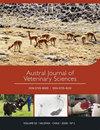精育饲粮中干酒糟和可溶物添加尿素对氮化合物和有机物消化的部位和程度
IF 0.8
4区 农林科学
Q3 VETERINARY SCIENCES
引用次数: 0
摘要
本试验选用4头荷兰斯坦阉牛(266±13 kg)(瘤胃和十二指肠瘘管),研究在含干酒糟和可溶物(DDGS)的蒸片玉米育肥猪饲粮中添加不同水平尿素(0%、0.4%、0.8%和1.2%)对氮化合物和有机物(OM)消化部位和程度、瘤胃N- nh3和血液尿素氮浓度的影响。提高尿素水平线性降低了十二指肠OM流量(P <0.04),增加了十二指肠总氮和非氨态氮流量(P <0.01),这是由于微生物氮和NH3-N流量线性增加(P <0.01),但对饲料剩余氮流量没有影响(P≥0.47)。提高尿素水平可线性提高瘤胃OM和饲粮N的消化率(P≤0.03),降低蛋白质效率(P <0.01),但不影响微生物效率。尿素的补充对瘤胃后消化没有影响。添加尿素可线性提高氮素化合物的全道消化(P <0.01),但不影响OM的全道消化。瘤胃pH平均值为6.09±0.03,不受尿素添加的影响(P≥0.97)。瘤胃NH3-N浓度随尿素添加量的增加而升高(线性组成,P<0.01)。血尿素浓度和血浆尿素也有相同的影响(P <0.01)。在此基础上,尿素可以添加到含DDGS的玉米基饲粮中。然而,为了优化瘤胃发酵并降低粪便中高氮排泄的风险,必须谨慎进行,以避免超过日粮中RDP的浓度。当饮食中含有较高水平的DDGS(即30%)时,这是相关的。关键词:发酵,瘤胃氮溶解度,DDGS,血浆尿素氮本文章由计算机程序翻译,如有差异,请以英文原文为准。
Site and extent of digestion of nitrogen compounds and organic matter in steers fed a finishing diet with dried distillers grains plus solubles supplemented with urea
Four Holstein steers (266 ± 13 kg) with ruminal and duodenal cannulae were used to evaluate the effect of inclusion of different levels of urea (0%, 0.4%, 0.8% and 1.2%) in a steam-flaked, corn-based finishing diet containing dried distillers grains plus solubles (DDGS) on the site and extent of N compounds and organic matter (OM) digestion, and on the ruminal N-NH3 and blood concentrations of urea nitrogen. Increasing the urea levels linearly decreased the OM flow to the duodenum ( P <0.04) and increased the total N and non-ammoniacal N flow to the duodenum ( P <0.01), which resulted from linear increases in the flow of microbial N and NH3-N ( P <0.01) without affecting the feed residual N flow ( P ≥0.47). Increasing the urea levels linearly increased ruminal digestion of OM and dietary N (P≤0.03), and decreased protein efficiency ( P <0.01) without affecting microbial efficiency. The urea supplementation did not affect post-ruminal digestion. Urea supplementation linearly increased ( P <0.01) total tract digestion of N compounds without affecting total tract digestion of OM. Ruminal pH averaged 6.09 ± 0.03 and was not affected ( P ≥0.97) by the inclusion of urea. Ruminal NH3-N concentration increased with urea supplementation (linear component, P<0.01). The same effect was observed for blood urea concentrations and plasma urea ( P <0.01). On the basis of the results observed here, urea can be incorporated in finishing corn-based diets that include DDGS. However, this must done carefully to avoid exceeding the RDP concentration in the diets in order to optimise ruminal fermentation and reduce the risk of high N excretion in the faeces. This is relevant when higher levels of DDGS are included in the diets (i.e. 30%). Key words : fermentation, ruminal nitrogen solubility, DDGS, plasmatic ureic nitrogen
求助全文
通过发布文献求助,成功后即可免费获取论文全文。
去求助
来源期刊

Austral Journal of Veterinary Sciences
Veterinary-General Veterinary
CiteScore
1.60
自引率
0.00%
发文量
18
期刊介绍:
Austral Journal of Veterinary Sciences (formerly Archivos de Medicina Veterinaria) publishes original scientific contributions in English, containing the latest developments and discoveries in veterinary sciences. The journal covers topics such as animal health and production, preventive medicine, zoonosis, pharmacology and therapeutics, methods of diagnosis, and other areas related to the veterinary field.
Austral Journal of Veterinary Sciences aims to divulge information about advances in veterinary medicine among universities, research centres, industries, government agencies, biologists, agronomists and veterinarians.
 求助内容:
求助内容: 应助结果提醒方式:
应助结果提醒方式:


